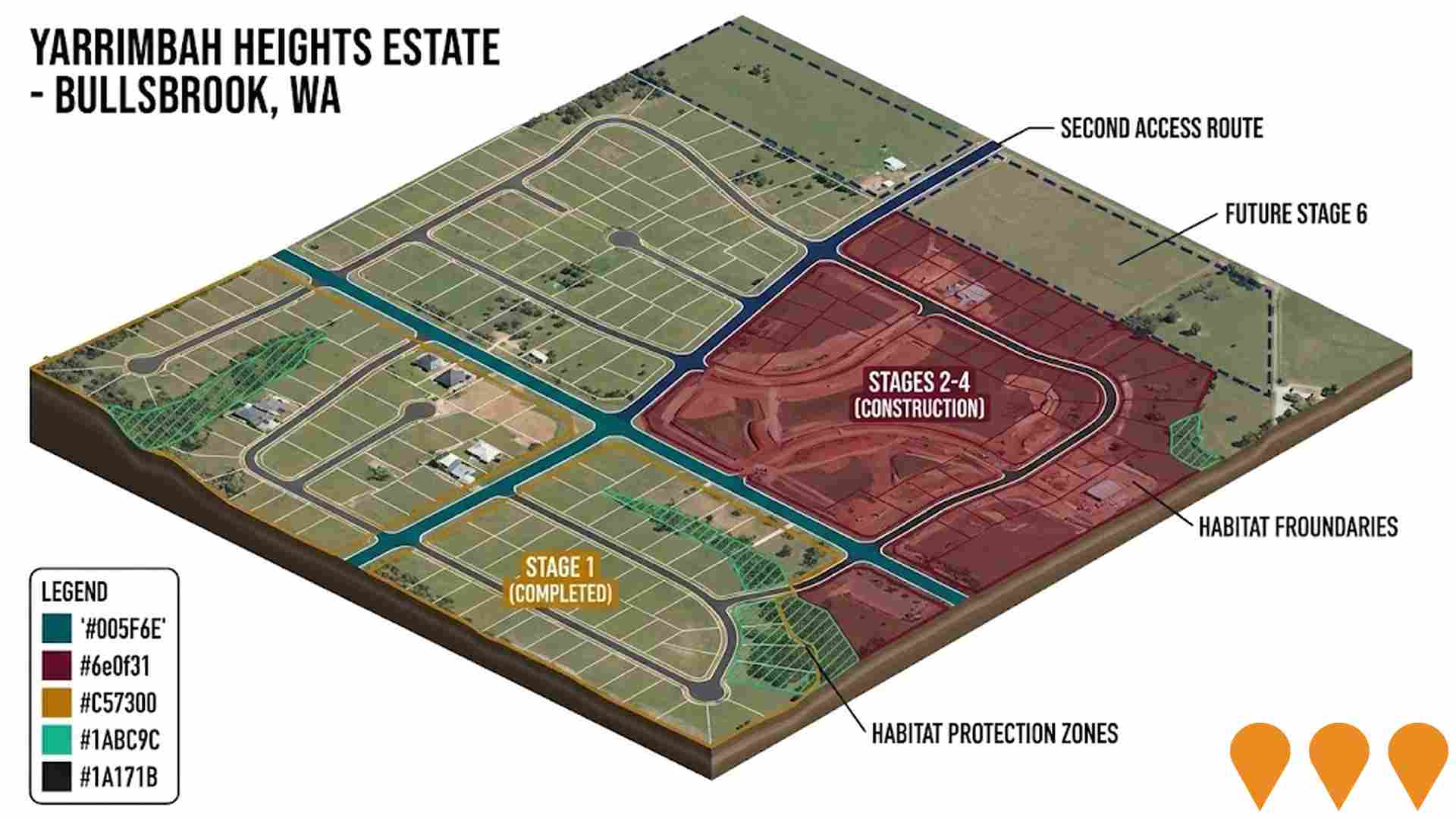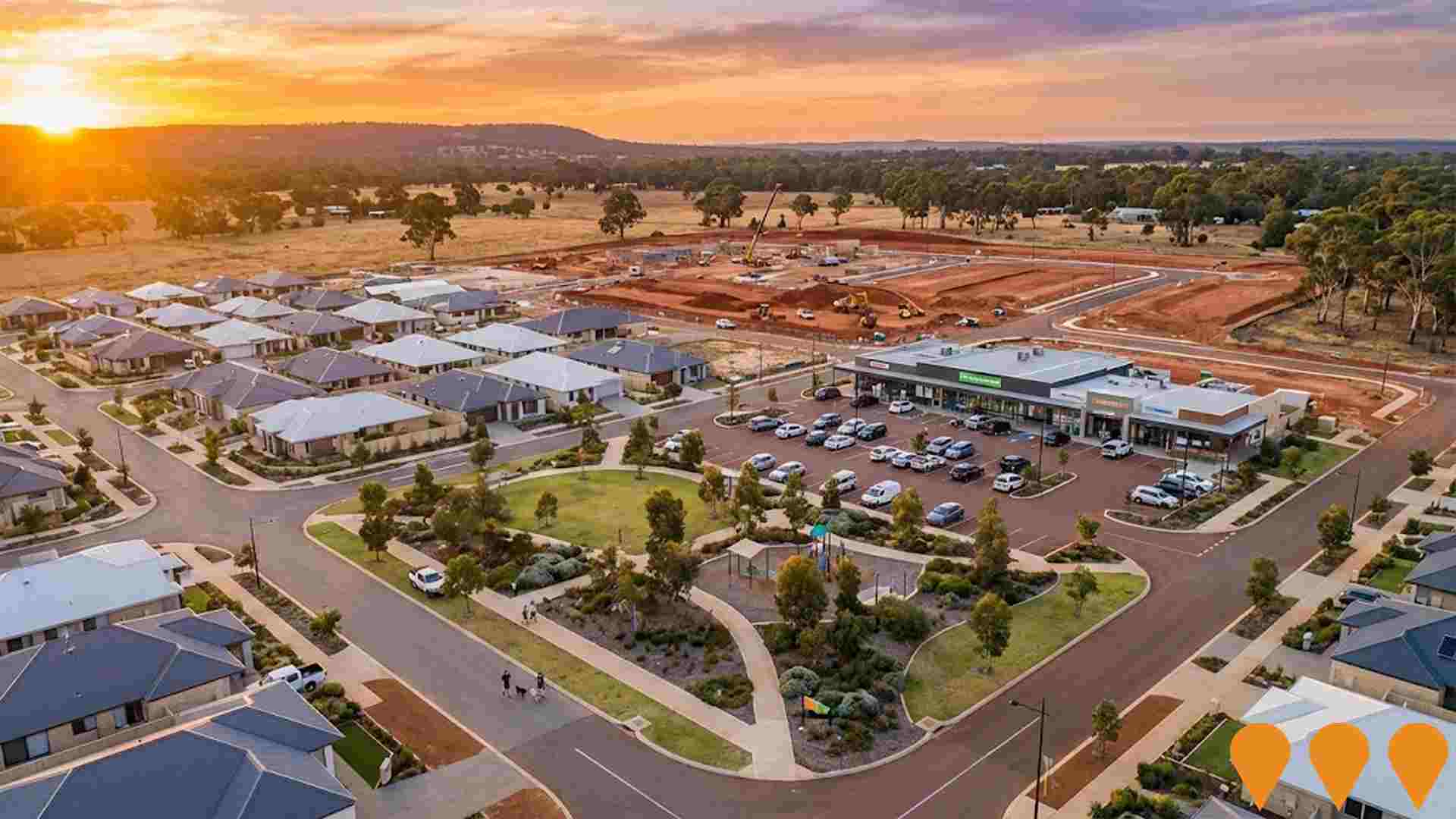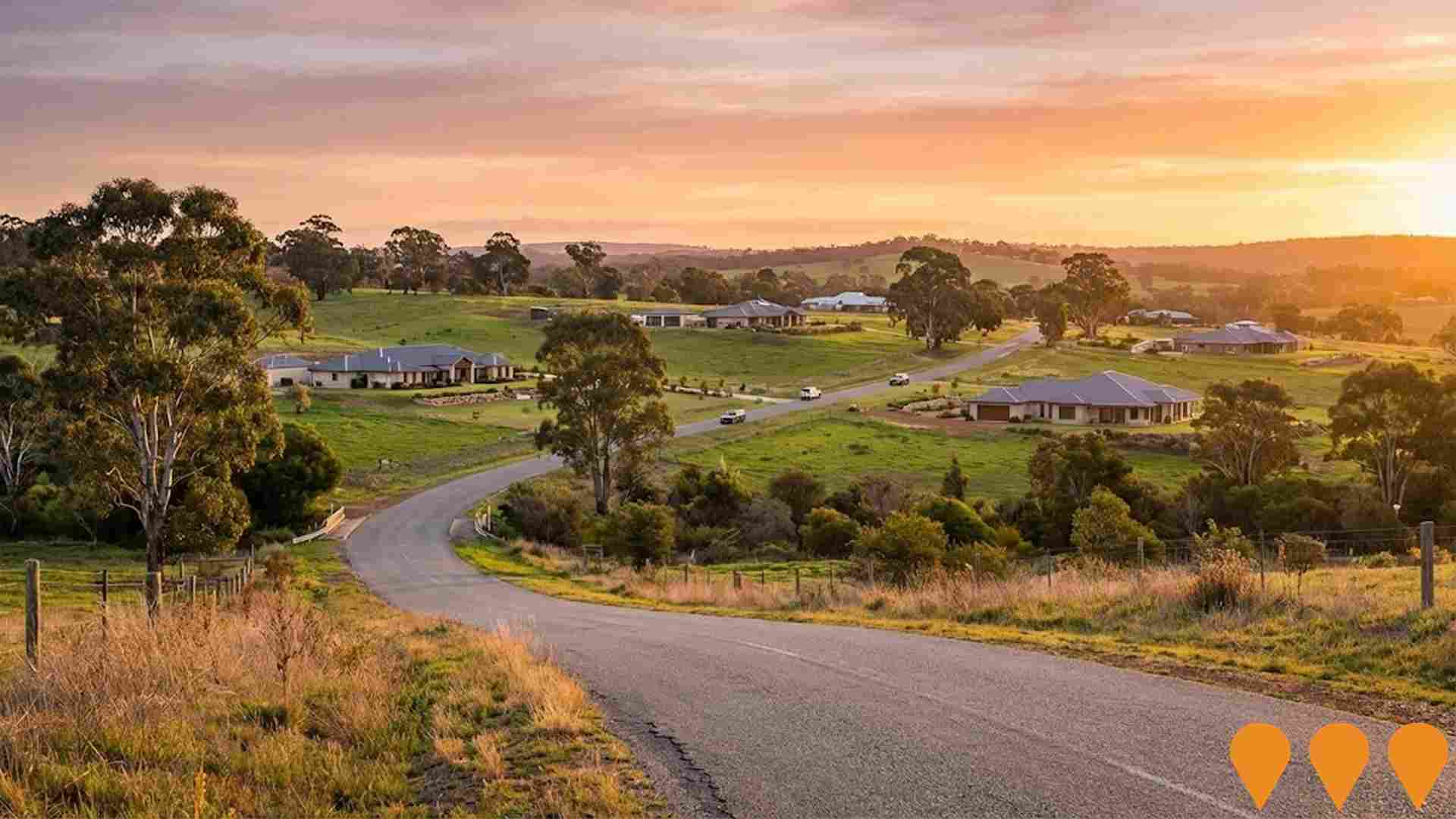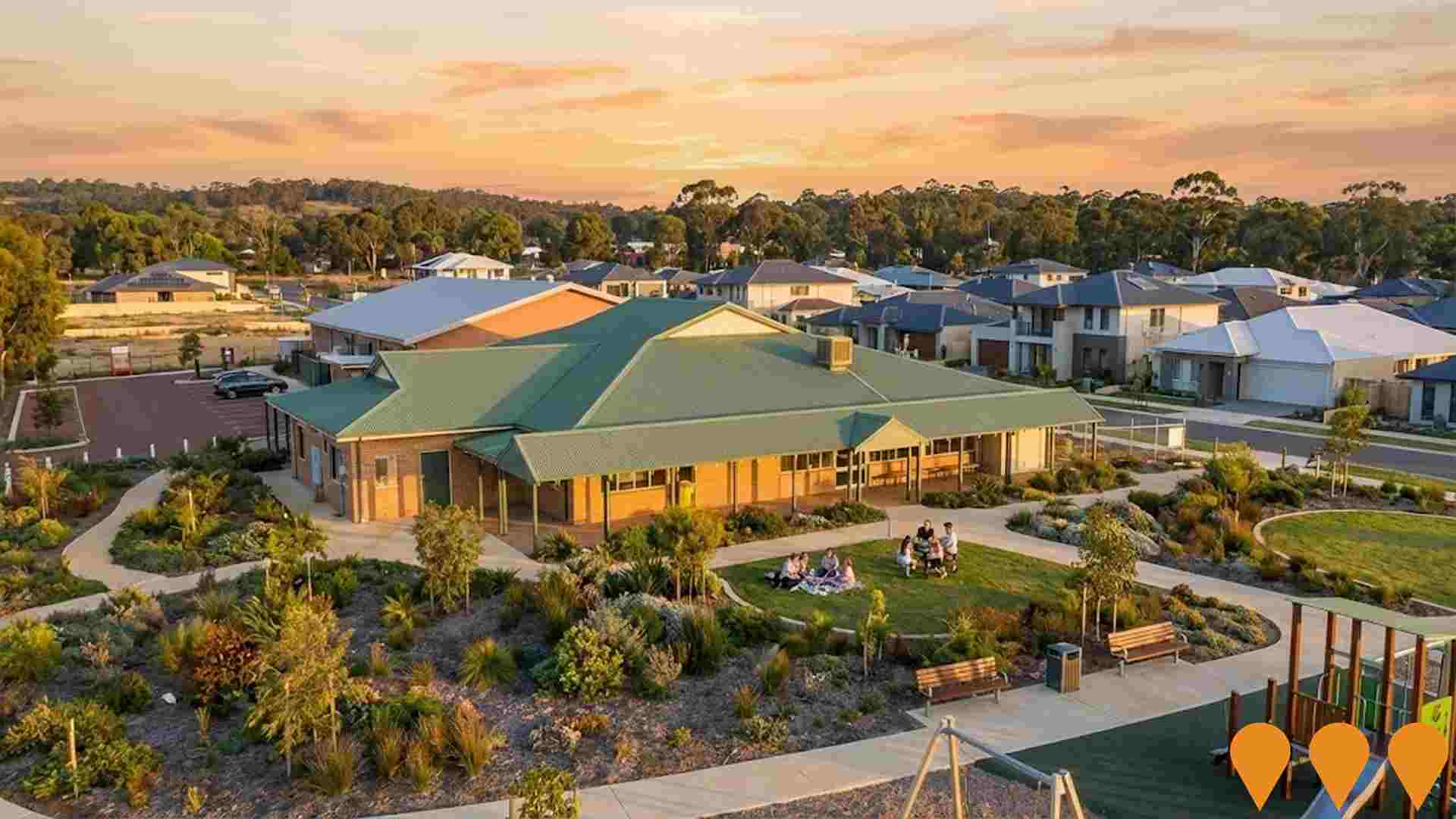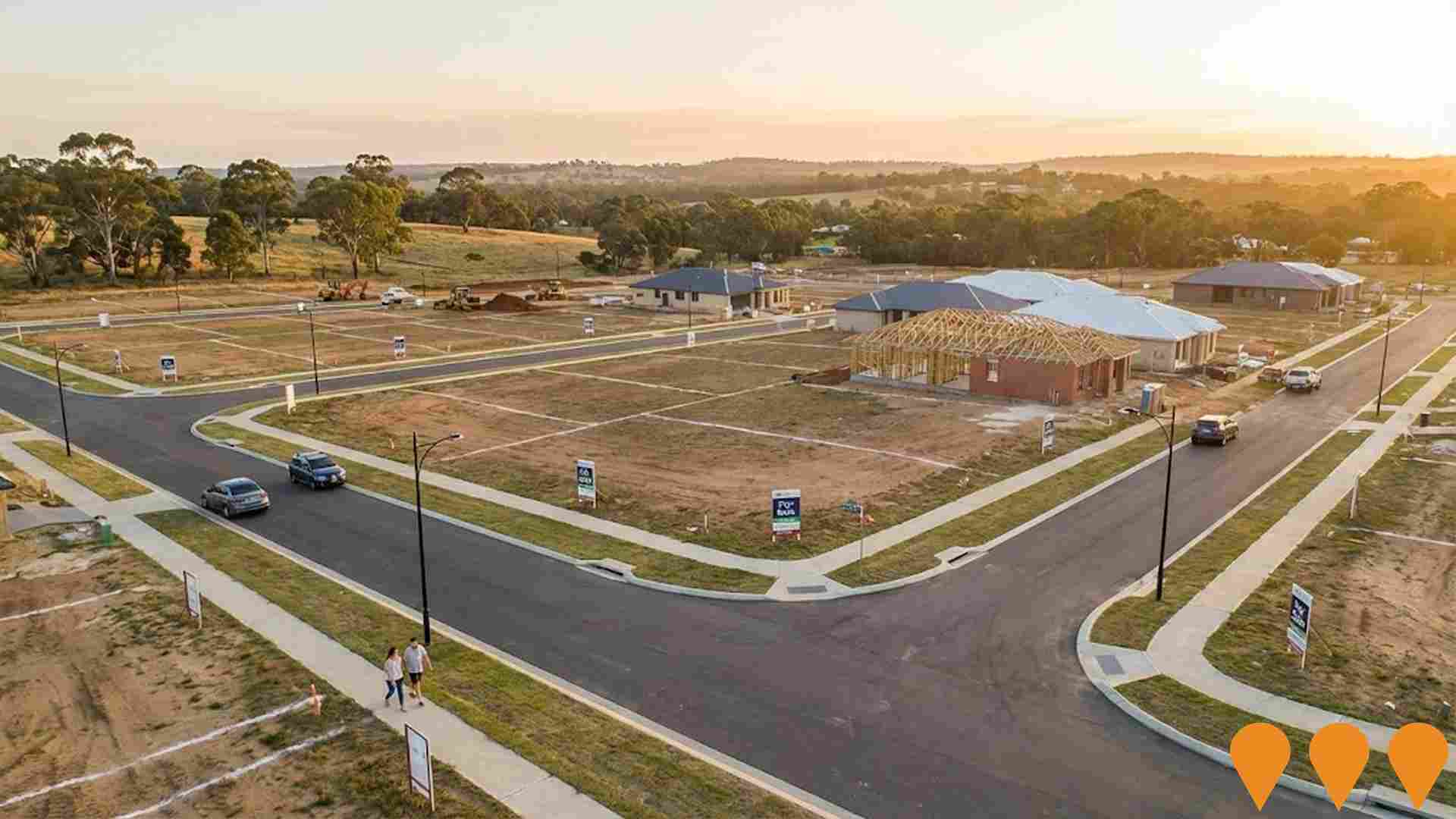Chart Color Schemes
est. as @ -- *
ABS ERP | -- people | --
2021 Census | -- people
Sales Activity
Curious about local property values? Filter the chart to assess the volume and appreciation (including resales) trends and regional comparisons, or scroll to the map below view this information at an individual property level.
Find a Recent Sale
Sales Detail
Population
Bullsbrook lies within the top quartile of areas nationally for population growth performance according to AreaSearch analysis of recent, and medium to long-term trends
Bullsbrook's population was approximately 7,868 as of November 2025. This figure represents a growth of 2,263 people, or 40.4%, since the 2021 Census, which recorded a population of 5,605. The increase is inferred from ABS estimates showing an estimated resident population of 6,653 in June 2024 and an additional 757 validated new addresses since the Census date. This results in a population density ratio of 31 persons per square kilometer. Bullsbrook's growth rate exceeded both national (8.9%) and state averages, making it a region leader in population growth. Interstate migration contributed approximately 62.9% of overall population gains during recent periods, although all factors including natural growth and overseas migration were positive contributors.
AreaSearch uses ABS/Geoscience Australia projections for each SA2 area released in 2024 with a base year of 2022. For areas not covered by this data, AreaSearch utilises growth rates by age cohort provided by the ABS in its latest Greater Capital Region projections released in 2023 based on 2022 data. Future population projections indicate significant increases for Bullsbrook, with an expected growth of 1,780 persons to 2041, representing a total gain of 7.2%.
Frequently Asked Questions - Population
Development
The level of residential development activity in Bullsbrook was found to be higher than 90% of real estate markets across the country
Bullsbrook saw approximately 119 new homes approved annually. Over the past five financial years, from FY21 to FY25, around 596 homes were approved, with an additional 66 approved so far in FY26. On average, about 1.8 people moved to the area each year for every dwelling built during these years, indicating a balanced supply and demand market that supports stable conditions.
The average construction cost of new properties was around $271,000. This financial year has seen approximately $20.7 million in commercial development approvals, reflecting moderate levels of commercial growth. Compared to Greater Perth, Bullsbrook has recorded 52.0% more development activity per person, providing ample choice for buyers and indicating strong developer confidence. All new construction consisted of detached dwellings, preserving the area's low-density nature and attracting space-seeking buyers. With around 47 people per dwelling approval, Bullsbrook shows characteristics of a growth area.
Population forecasts indicate Bullsbrook will gain approximately 565 residents by 2041. Based on current development patterns, new housing supply should readily meet demand, offering good conditions for buyers and potentially facilitating population growth beyond current projections.
Frequently Asked Questions - Development
Infrastructure
Bullsbrook has limited levels of nearby infrastructure activity, ranking in the 11thth percentile nationally
Changes to local infrastructure significantly influence an area's performance. AreaSearch has identified 25 projects likely impacting the area. Notable projects include Yarrimbah Heights Estate, The Village at Bullsbrook, Bullsbrook Town Centre Revitalisation (Kingsford Town Centre), and Kingsford Town Centre. Below is a list of most relevant ones.
Professional plan users can use the search below to filter and access additional projects.
INFRASTRUCTURE SEARCH
 Denotes AI-based impression for illustrative purposes only, not to be taken as definitive under any circumstances. Please follow links and conduct other investigations from the project's source for actual imagery. Developers and project owners wishing us to use original imagery please Contact Us and we will do so.
Denotes AI-based impression for illustrative purposes only, not to be taken as definitive under any circumstances. Please follow links and conduct other investigations from the project's source for actual imagery. Developers and project owners wishing us to use original imagery please Contact Us and we will do so.
Frequently Asked Questions - Infrastructure
Bullsbrook Freight and Industrial Land Use Strategy
Long-term strategic framework to guide the development of over 2,500 hectares of industrial and employment land in Bullsbrook, supporting a future intermodal freight terminal and associated logistics and advanced manufacturing uses. Expected to generate up to 40,000 jobs over a 50+ year horizon.

Bullsbrook Town Centre Revitalisation (Kingsford Town Centre)
Major revitalisation and development of Bullsbrook's town centre as part of the Kingsford Estate, including a new mixed-use commercial precinct, public open space, improved pedestrian connectivity, and an expected 'market-style' **Woolworths supermarket** with a liquor store and specialty shops. The Town Centre is planned to be developed in stages as an urban village and key employment and activity hub, with construction on the Kingsford Estate already commenced and the Woolworths development expected to be completed by the end of 2025.
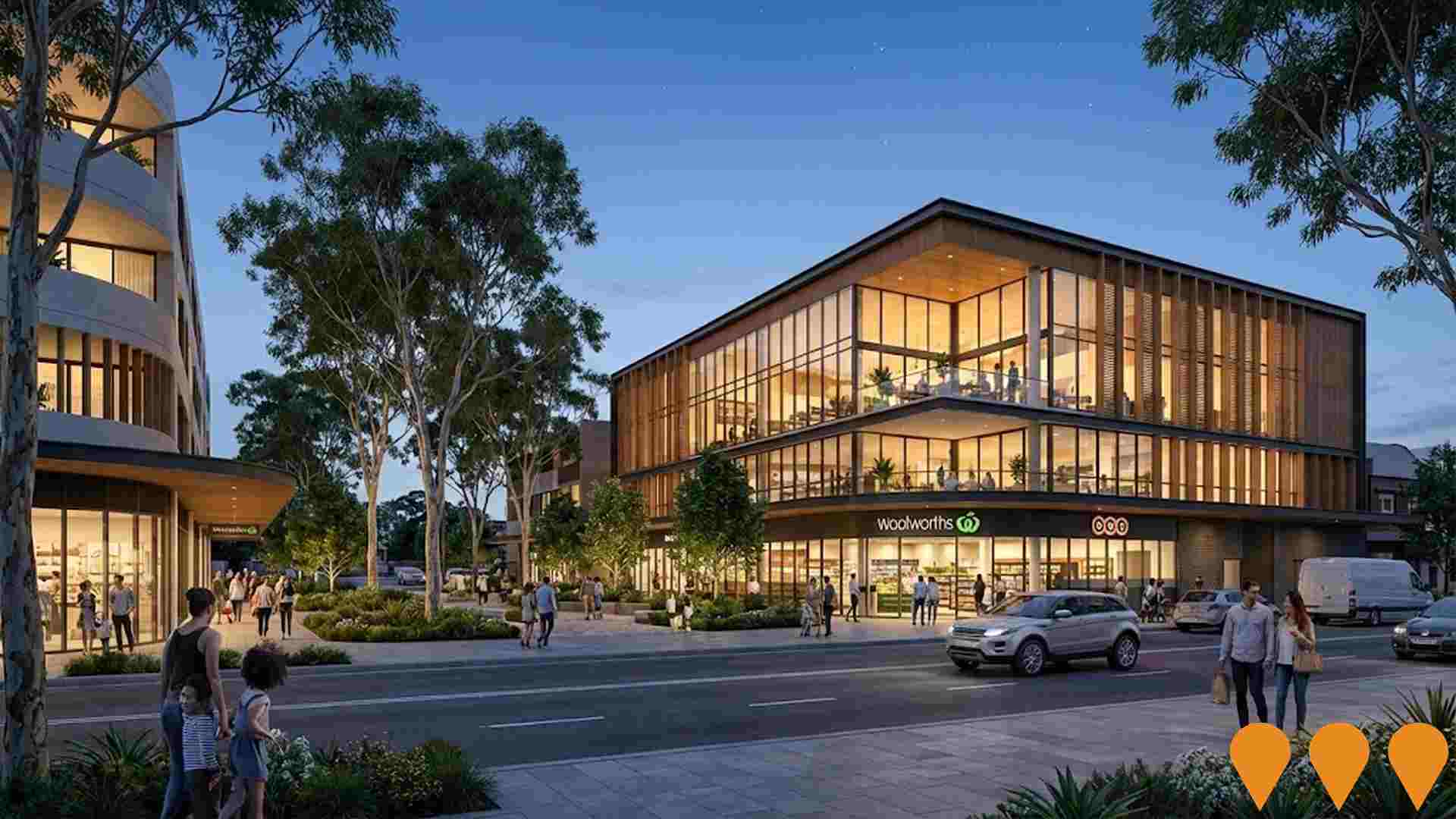
Kingsford Town Centre
Neighbourhood shopping centre within the Kingsford masterplanned community in Bullsbrook, anchored by a full-line Woolworths supermarket (3,600 m2), BWS liquor and 15 specialty tenancies. Stage 1 of the broader mixed-use town centre that will eventually include tavern, childcare, medical centre, main street retail and community facilities.

Brooklane Shopping Centre
Neighbourhood shopping centre serving northern Ellenbrook. Opened July 2021, anchored by Woolworths on an initial 12-year term, with 14 tenants, one office and a freestanding pad site. Approx. 5,053 sqm NLA.

North Ellenbrook (East) District Structure Plan
499-hectare masterplanned residential community in Perth's north-east corridor led by Lendlease. Will deliver approximately 5,500 dwellings for up to 16,500 residents. District Structure Plan approved by WAPC in August 2022. Metropolitan Region Scheme Amendment 1399/41 (North Ellenbrook) was gazetted on 17 December 2024, lifting Urban Deferred status and rezoning the land to Urban zone, enabling subdivision and development to proceed. Includes future high school site, multiple primary schools, neighbourhood centre, district playing fields and conservation areas protecting threatened ecological communities and Western Swamp Tortoise habitat.

Bullsbrook Industrial Park
The Bullsbrook Industrial Park is a 186ha (165ha developable) general industry precinct, formerly known as Bullsbrook Industrial Precinct (Stage 1), strategically positioned between NorthLink WA (Tonkin Hwy) and Great Northern Hwy. It features construction-ready industrial lots from 2,500sqm to 30ha, zoned for 24/7 general industrial operations. Development of the first stage commenced in 2021, and the estate has approved subdivision. Phase 1 lots have been oversubscribed, and Release 2 is currently registering interest. The entire Northern Gateway Industrial Park (Bullsbrook Industrial Park and Muchea Industrial Park) has recently been listed for sale by the current owner, Harvis. The estate is located adjacent to the Perth-Geraldton Rail Line, has RAV-7 (36.5m) truck access, and is planning for future rail logistics connections and a potential Intermodal Freight Terminal (IFT).

Tonkin Highway North Ellenbrook Interchange
Tonkin Highway North Ellenbrook Interchange is a planned grade separated interchange on Tonkin Highway between Warbrook Road and Maralla Road at Bullsbrook, north of Ellenbrook. Led by Main Roads WA, the 100 million dollar project will deliver a single point urban interchange and a grade separated principal shared path, improving safety and travel times on the Tonkin Highway corridor. The interchange is a key enabler for the North Ellenbrook East and West District Structure Plans, unlocking more than 12,500 future residential lots and supporting around 36,000 residents with better access to schools, jobs and services. Planning and approvals are underway, with procurement for design and construction expected to commence in 2026 and construction targeted for completion in late 2027.
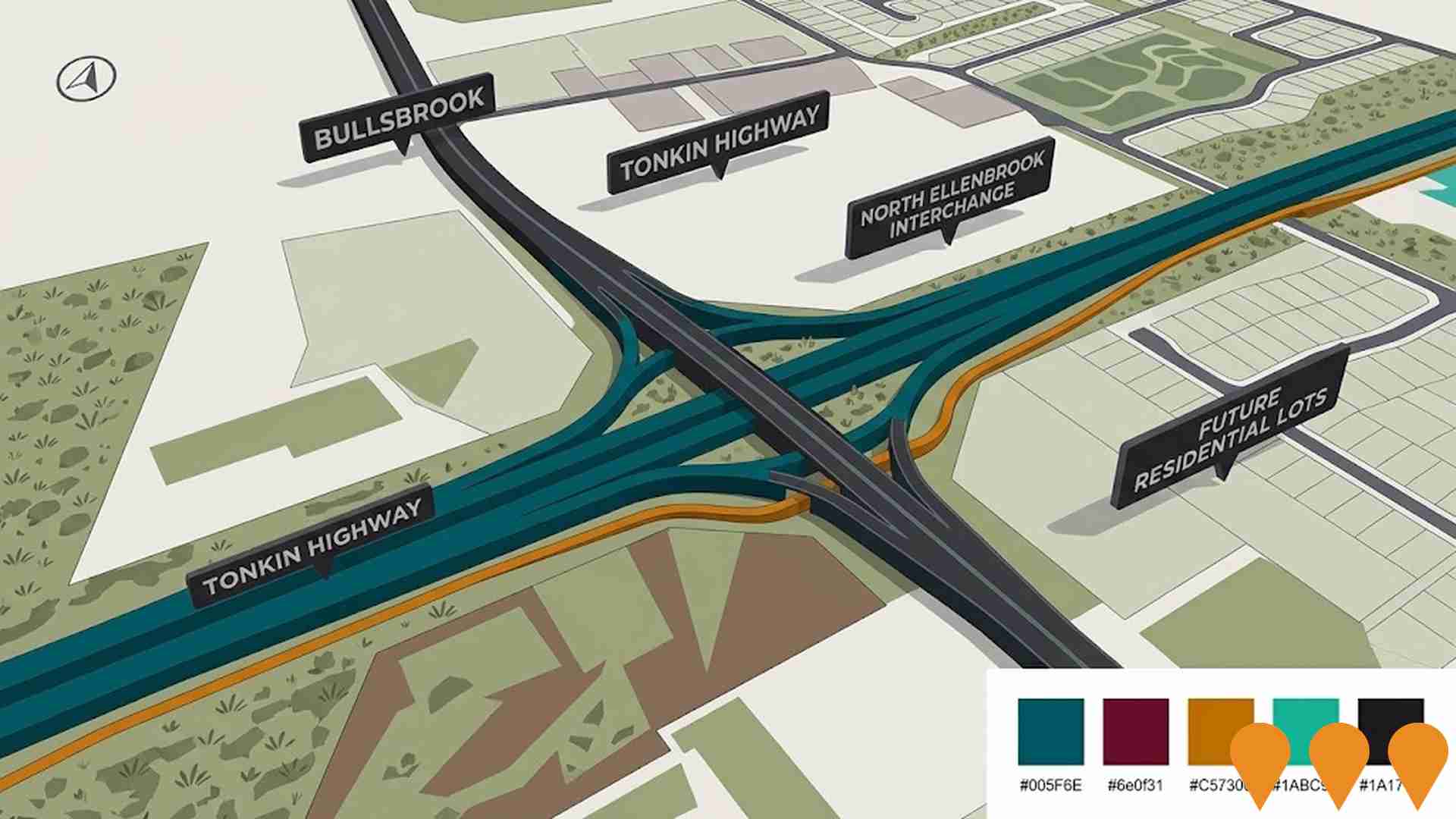
Bullsbrook District Open Space and Community Centre
New district-level community infrastructure including open space masterplan, community centre facilities, sports fields, and recreational amenities. Part of 5-year infrastructure plan for growing Bullsbrook community.
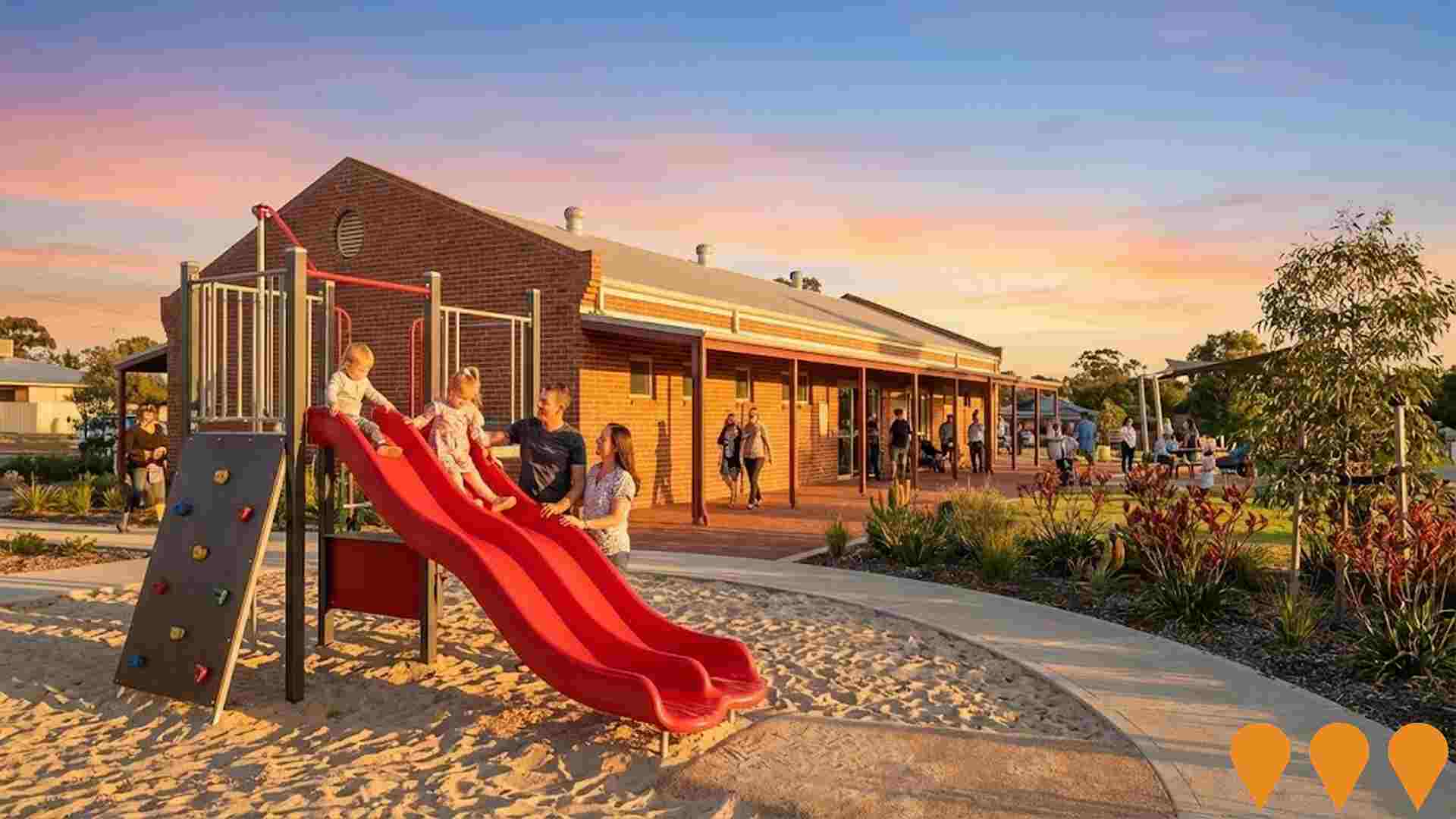
Employment
Employment conditions in Bullsbrook demonstrate strong performance, ranking among the top 35% of areas assessed nationally
Bullsbrook has a diverse workforce with both white and blue collar jobs. The construction sector is prominent, with an unemployment rate of 3.0%.
In the past year, employment grew by 4.6%. As of June 2025, 3,863 residents are employed, with an unemployment rate of 3.9%, 0.9% lower than Greater Perth's rate. Workforce participation is similar to Greater Perth at 65.2%. Key industries include construction, mining, and health care & social assistance.
Agriculture, forestry & fishing has notably high employment levels, 6.4 times the regional average. However, health care & social assistance has limited presence with 9.0% employment compared to 14.8% regionally. Many residents commute elsewhere for work based on Census data. Between June 2024 and June 2025, employment increased by 4.6%, labour force grew by 4.2%, reducing the unemployment rate by 0.4 percentage points. In comparison, Greater Perth had employment growth of 3.7% and a slight increase in unemployment. Jobs and Skills Australia's national employment forecasts from May 2025 suggest Bullsbrook's employment could grow by approximately 5.4% over five years and 11.8% over ten years, based on industry-specific projections.
Frequently Asked Questions - Employment
Income
Income analysis reveals strong economic positioning, with the area outperforming 60% of locations assessed nationally by AreaSearch
Bullsbrook had a median taxpayer income of $59,089 and an average of $76,256 according to postcode level ATO data aggregated by AreaSearch for the financial year 2022. This is high nationally compared to Greater Perth's median income of $58,380 and average income of $78,020. By September 2025, estimates based on a 14.2% Wage Price Index growth would be approximately $67,480 (median) and $87,084 (average). Census data shows household, family and personal incomes in Bullsbrook are around the 61st percentile nationally. The largest income bracket comprises 37.3% earning between $1,500 to $2,999 weekly, with 2,934 residents falling into this category, similar to the surrounding region where 32.0% occupy this bracket. High housing costs consume 16.4% of income, but strong earnings place disposable income at the 60th percentile nationally. The area's SEIFA income ranking places it in the 5th decile.
Frequently Asked Questions - Income
Housing
Bullsbrook is characterized by a predominantly suburban housing profile, with above-average rates of outright home ownership
Bullsbrook's dwelling structures, as per the latest Census, were 99.7% houses and 0.4% other dwellings (semi-detached, apartments, 'other' dwellings), contrasting with Perth metro's 89.1% houses and 10.9% other dwellings. Home ownership in Bullsbrook stood at 26.9%, with mortgaged dwellings at 57.3% and rented ones at 15.7%. The median monthly mortgage repayment was $1,950, surpassing Perth metro's average of $1,842. Median weekly rent in Bullsbrook was $350, slightly higher than Perth metro's $340. Nationally, Bullsbrook's mortgage repayments exceeded the Australian average of $1,863, while rents were lower than the national figure of $375.
Frequently Asked Questions - Housing
Household Composition
Bullsbrook features high concentrations of family households, with a fairly typical median household size
Family households comprise 80.7% of all households, including 36.9% couples with children, 30.7% couples without children, and 12.0% single parent families. Non-family households account for the remaining 19.3%, with lone person households at 16.8% and group households comprising 2.5%. The median household size is 2.8 people, which matches the Greater Perth average.
Frequently Asked Questions - Households
Local Schools & Education
Bullsbrook faces educational challenges, with performance metrics placing it in the bottom quartile of areas assessed nationally
The area's university qualification rate is 13.1%, significantly lower than Australia's average of 30.4%. This presents both a challenge and an opportunity for targeted educational initiatives. Bachelor degrees are the most common at 10.1%, followed by postgraduate qualifications (1.6%) and graduate diplomas (1.4%). Vocational credentials are prominent, with 44.8% of residents aged 15+ holding them - advanced diplomas at 9.3% and certificates at 35.5%.
Educational participation is high, with 28.6% of residents currently enrolled in formal education. This includes 11.4% in primary, 8.9% in secondary, and 2.6% in tertiary education. Bullsbrook College serves the area, enrolling 894 students as of its latest count. The school offers integrated K-12 education for academic continuity. School places per 100 residents are 11.9, below the regional average of 15.7. Some students may attend schools in adjacent areas due to this discrepancy.
Frequently Asked Questions - Education
Schools Detail
Nearby Services & Amenities
Transport
Transport servicing is very low compared to other areas nationally based on assessment of service frequency, route connectivity and accessibility
Transport analysis indicates 25 active transport stops in Bullsbrook, consisting of bus services only. These stops are served by three distinct routes, offering a total of 147 weekly passenger trips. Transport accessibility is considered limited, with residents situated an average of 2499 meters from the nearest stop.
Service frequency averages 21 trips daily across all routes, equating to roughly five weekly trips per individual stop.
Frequently Asked Questions - Transport
Transport Stops Detail
Health
Bullsbrook's residents are healthier than average in comparison to broader Australia with prevalence of common health conditions quite low across both younger and older age cohorts
Health data shows relatively positive outcomes for Bullsbrook residents. Prevalence of common health conditions is quite low across both younger and older age cohorts.
Approximately 58% of the total population (4,547 people) have private health cover, compared to 54.1% in Greater Perth. The most common medical conditions are mental health issues and arthritis, affecting 8.4% and 8.1% of residents respectively. Around 69.7% of residents declare themselves completely clear of medical ailments, compared to 72.6% across Greater Perth. As of the latest data (2016), 14.2% of residents are aged 65 and over (1,121 people), which is higher than the 12.6% in Greater Perth. Health outcomes among seniors are above average, broadly in line with the general population's health profile.
Frequently Asked Questions - Health
Cultural Diversity
Bullsbrook ranks below the Australian average when compared to other local markets across a number of language and cultural background related metrics
Bullsbrook, as per the census conducted on 9 August 2016, showed a cultural diversity below average. The population was predominantly composed of citizens (86.6%), with a majority born in Australia (76.8%) and speaking English at home exclusively (94.9%). Christianity was the prevalent religion, accounting for 42.4% of Bullsbrook's population.
Notably, Judaism had an overrepresentation compared to Greater Perth, comprising 0.1% versus 0.1%. In terms of ancestry, the top three groups were English (34.1%), Australian (30.1%), and Scottish (8.1%), each substantially higher than their respective regional averages of 26.2%, 22.0%, and not specified respectively. Other ethnic groups with notable divergences included New Zealanders at 1.2% versus the regional average of 1.0%, Dutch at 1.8% versus 1.3%, and South Africans at 0.7% versus 0.8%.
Frequently Asked Questions - Diversity
Age
Bullsbrook's population is slightly younger than the national pattern
The median age in Bullsbrook is close to Greater Perth's average of 37 years and equivalent to Australia's median age of 38 years. Compared to Greater Perth, Bullsbrook has a higher proportion of residents aged 55-64 (13.4%) but fewer residents aged 35-44 (12.0%). Between the 2021 Census and now, the percentage of residents aged 25 to 34 has increased from 12.9% to 13.7%, while the percentage of those aged 45 to 54 has decreased from 15.4% to 13.5%. By the year 2041, Bullsbrook's age composition is expected to change significantly. The number of residents aged 65-74 is projected to grow by 30%, reaching 920 from 708. Those aged 65 and above are expected to comprise 89% of the population growth. Conversely, population declines are projected for those aged 25 to 34 and those under age five.
